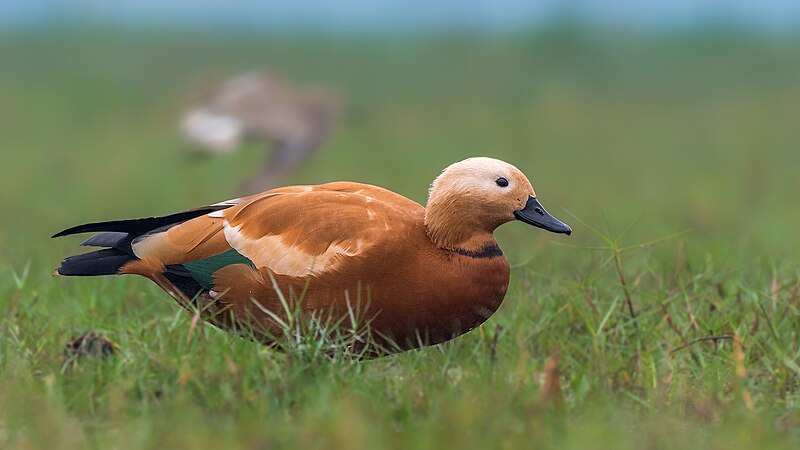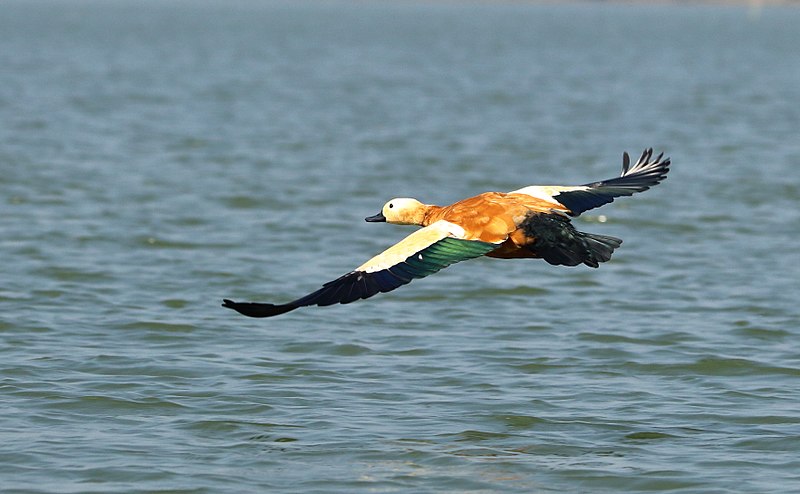Ruddy Shelduck Bird Details
Tadorna ferruginea
Ruddy Shelduck,Brahminy Duck, Orange Shelduck;
Surkhab
Peter Simon Pallas, 1764
Anseriformes (DUCKS)
Anatidae
Tadorna
Central Asia, Bangladesh, Pakistan, China, Mongolia, Turkey, Russia, and parts of Europe.
India (Himalayan foothills, Rajasthan, Gujarat, and Assam, Keoladeo National Park, Chilika Lake, and Sambhar Lake.)
Appearance :
The Ruddy Shelduck is striking with its orange-brown body and lighter, paler head. It has black primary feathers, and the wings have green iridescence in flight. The males and females have similar coloration, though males may have a faint dark ring around the neck during the breeding season.
Behaviour :
These birds are territorial during the breeding season and are known for their strong pair bonds. They are migratory and travel in flocks during the non-breeding season.
Habitat :
Found in a variety of freshwater habitats, including lakes, rivers, marshes, and reservoirs. During winter, they may also frequent estuaries and coastal lagoons.
Diet :
They are omnivores, feeding primarily on aquatic plants, seeds, grasses, and small aquatic creatures like crustaceans, insects, and occasionally small fish.
Conservation Status :
Least Concern
Distribution :
Found across a wide range, from Central Asia to Southeast Asia and parts of Europe.
Population Size :
The global population is estimated to be between 170,000 to 220,000 individuals, with stable trends in most regions.
Life Span :
Typically, 10 to 15 years in the wild.
Body And Tarsus:
- Body: The Ruddy Shelduck has a robust and stocky body with a distinct orange-brown color. The body is well-proportioned with long wings and a slightly rounded tail.
- Tarsus Length: 5.5 to 7 cm (varies between individuals).
Head And Bill :
- Head: The head is pale orange or light cream in color, with no prominent markings in females. Males may have a subtle black ring around the neck during the breeding season.
- Bill: The bill is black, straight, and slightly broad with a smooth surface.
- Bill Length: Approximately 4 to 5 cm in length.
Length :
The overall length of the Ruddy Shelduck is about 58 to 70 cm, making it one of the larger duck species.
Neck :
The neck is relatively long and thick, with a subtle color gradient from pale orange to deeper orange-brown near the body.
Size :
Medium to large-sized duck, with males generally being slightly larger than females.
Tail Details :
- Tail: The tail is short and rounded with black feathers.
- Tail Length: Around 10 to 12 cm.
- Feathers: The body feathers are orange-brown with paler shades on the head and neck. The wings have a distinctive black and white contrast, with iridescent green on the secondary feathers.
Weight :
Typically weighs between 1 to 1.6 kg
Wing :
Broad wings that are well-suited for long flights. The wings are strong and capable of sustained flight, with rounded tips.
Wing Span :
The wingspan ranges between 110 to 135 cm
Facial Feature :
The face is relatively plain, with a smooth orange color. There are no distinctive markings, making it less pronounced compared to other species.
Nest Details :
- Nest: Nests are often built in cavities, brush, or reed beds, sometimes near water bodies or on elevated ground to avoid flooding.
- Nest made up of: The nest is constructed using grass, reeds, feathers, and other plant materials for insulation and camouflage.
Breeding Season :
The breeding period typically occurs between March and July.
Nesting Season :
The nesting season coincides with the breeding period.
Egg Color :
The eggs are typically pale blue or greenish in color.
Egg Length :
Approximately 5.5 to 7 cm long.
Egg Width and Weight :
- Egg Width: About 4 to 5 cm wide.
- Egg Weight: Each egg weighs around 60 to 80 grams.
Clutch Size :
The average clutch size ranges from 5 to 10 eggs.
No. of Broods :
Generally, they raise one brood per season, although in some favorable conditions, they may attempt a second brood.
Incubation Period :
The incubation period lasts for about 28 to 30 days.
Nestling Period :
The young ducklings are precocial and leave the nest shortly after hatching, but they remain dependent on their parents for about 8 to 10 weeks.
Vocalization :
They produce a variety of sounds, including soft whistles, quacks, and grunting calls.
Sex Demorphism :
Yes, there is some sexual dimorphism. Males are generally more vibrant in color with a slightly more pronounced neck and heavier body, while females are more muted in coloration.
Migration Details :
- Migration Pattern: The Ruddy Shelduck is partially migratory, with populations moving to suitable wintering grounds based on food availability and climate.
- Migration Period: Migration usually occurs between late summer and early autumn as they leave breeding grounds and return again in spring.
- Migration Route: They migrate from their breeding grounds in Central Asia, Russia, and the Himalayas to wintering areas in India, Pakistan, and Southeast Asia. The routes can vary, often following wetland corridors.
Explore More Birds Of Same Genus



